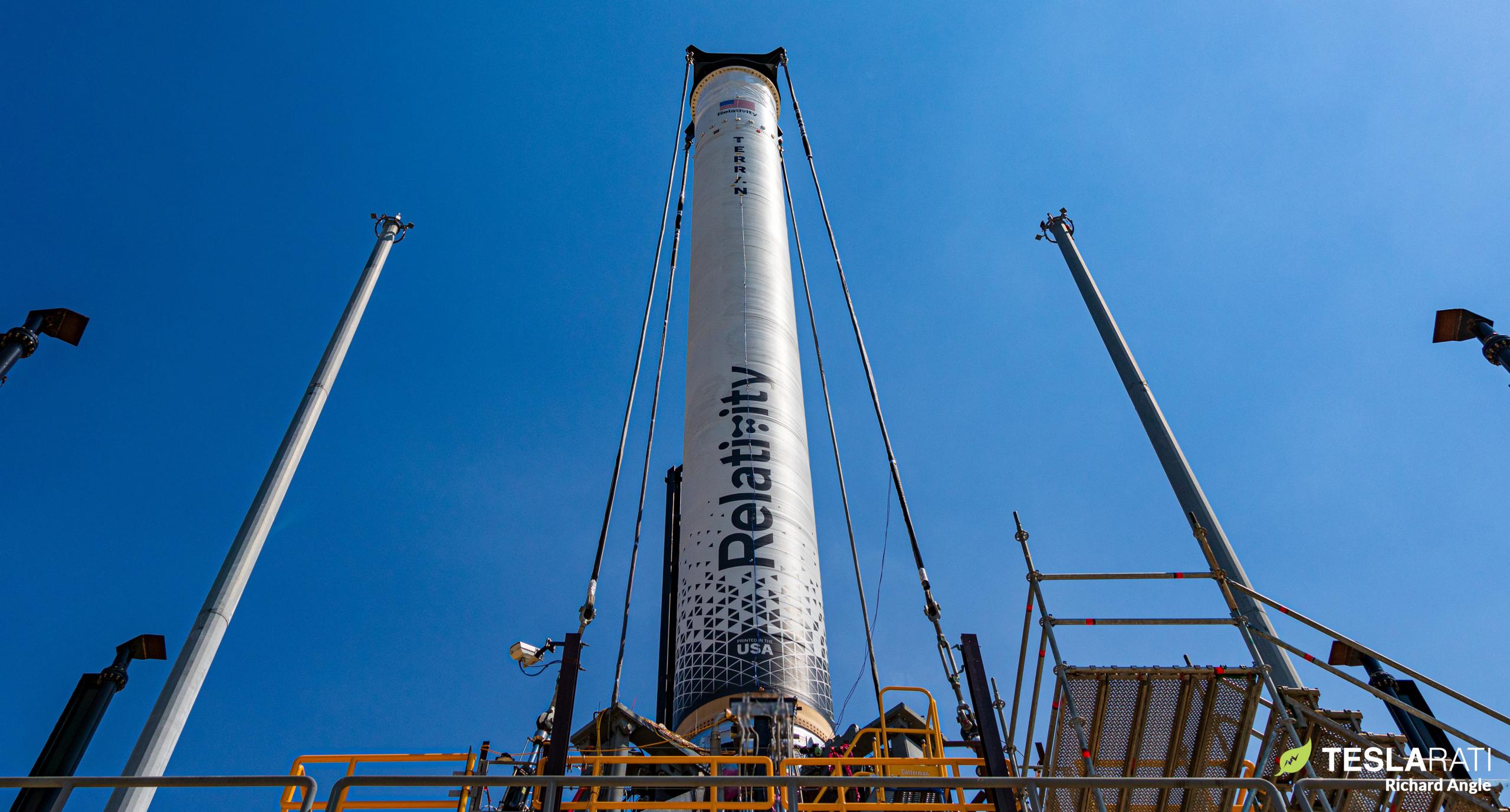
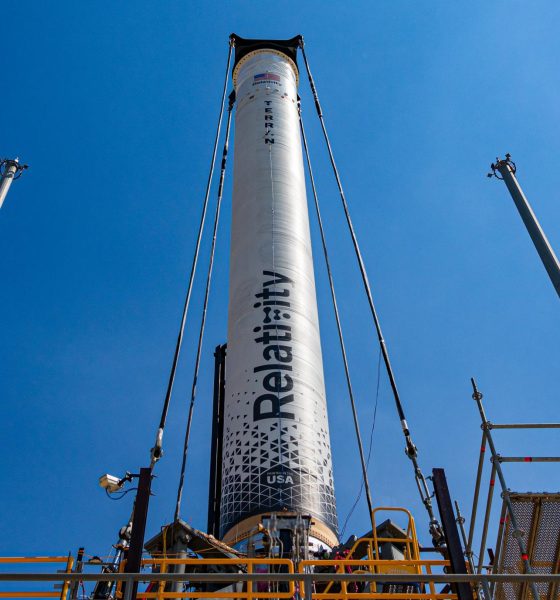
News
Relativity’s first 3D-printed rocket aims to debut a new rocket fuel
Relativity can almost taste the vacuum of space. A substantial amount of work remains, but the startup continues to defy expectations with its relentless and methodical push towards the first orbital launch of a 3D-printed rocket.
Founded in 2015, the Los Angeles-based aerospace company has taken its few years of obligatory delays in stride while pursuing a 2020 debut for its (relatively) small Terran 1 rocket. In a world with dozens of serious rocket startups, missing one’s initial launch target is practically a rite of passage – the path to orbit is never as straight and bump-free as the highway on-ramps that are often promised in pitch decks. Relativity Space, however, is no average rocket startup.
Save for SpaceX, which operates in a league of its own, no other private rocket startup has come close to matching the $1.3 billion Relativity has raised to develop Terran 1 and the much larger Terran R. More importantly, in a recent interview with Aviation Week, CEO Tim Ellis (a former Blue Origin engineer) revealed that the company could be “weeks away” from the first launch of Terran 1, a rocket that is 85% 3D-printed by mass and could simultaneously debut a new kind of rocket fuel.
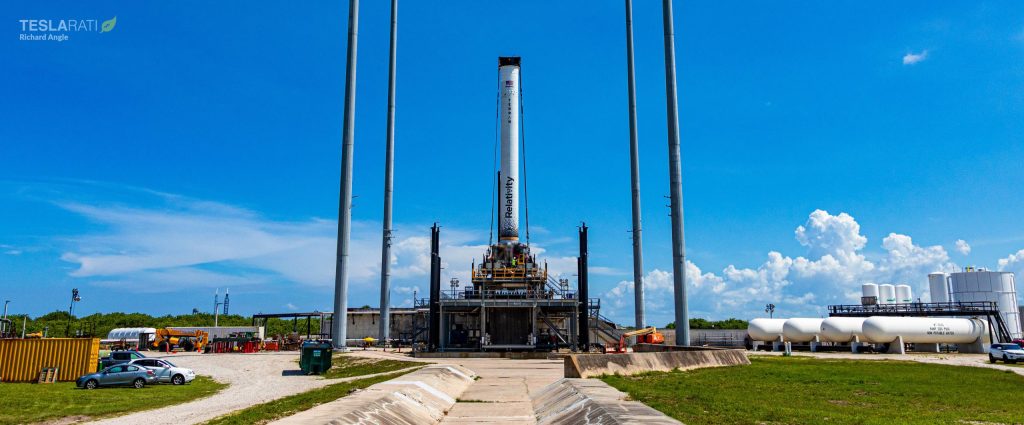
Once fully assembled, Terran 1 – weighing around 9.3 tons (~20,500 lb) empty and measuring 33.5 meters (110 ft) tall – will be the largest metal 3D-printed object in the history of the technology. From that perspective, it’s hardly surprising that Relativity Space is a few years behind schedule. In fact, it’s odd that the startup isn’t more delayed, and it’s even more impressive that Terran 1’s first launch campaign has gone as smoothly as it has.
Slow, Smooth and Fast
Terran 1 Flight 1’s booster stage and upper stage both arrived at the company’s leased Cape Canaveral Space Force Station LC-16 pad sometime in May 2022. Terran 1’s first stage came directly from the California factory. The second stage (S2), however, first shipped to a Mississippi test stand a few months prior and, on its first try, completed a full-duration multi-minute static fire test known as a mission duty cycle (MDC) – about as close as it’s possible to get to replicating orbital upper stage operations on the ground. The flawless MDC was preceded by a number of simpler precursor tests, of course, but the rocket performed more or less as expected throughout the entire qualification program. If Terran’s second stage ignites again, it’ll be at the edge of space.
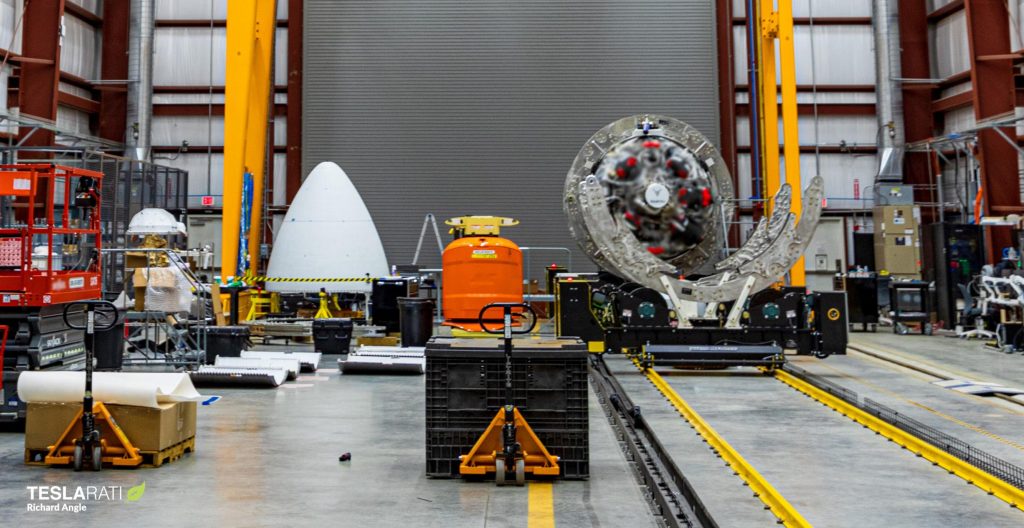
Since June, the critical path for Terran 1’s launch debut has thus been qualifying the first finished Terran booster. Rather than modify its Mississippi test facilities, Relativity decided to temporarily modify its heavily upgraded LC-16 pad to support booster qualification testing. Thanks to the heroic work of a shockingly small team of five people, the pad was ready to kick off testing as soon as the Terran 1 booster arrived in Florida. Even more surprisingly, senior manager Lorenzo Locante says that LC-16 – practically a new pad after Relativity’s extensive modifications – has “performed perfectly” during every booster qualification test attempted thus far.
That testing has included pneumatic proofing (an ambient-temperature gas pressure test), possible cryogenic proof tests, multiple rounds of propellant loading, preignition testing of its nine Aeon engines, and multiple spin-start tests (the last step before static fire testing) with the same engines. Given that LC-16 and Terran 1 must handle cryogenic oxidizer (liquid oxygen) and cryogenic fuel (liquid methane), which can easily create a flammable and bomb-like mixture of gases from even the smallest of leaks, it’s difficult to emphasize just how difficult it is to ensure that a complex launch pad and rocket perform nominally during their first joint testing.
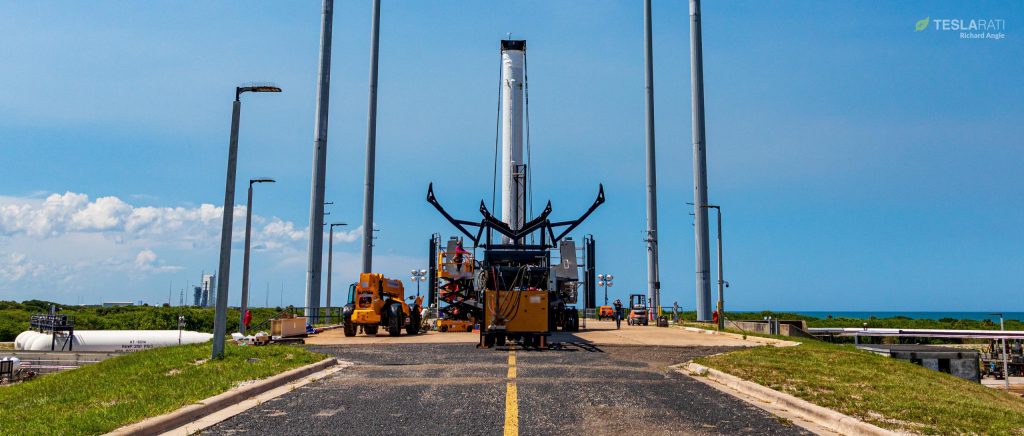
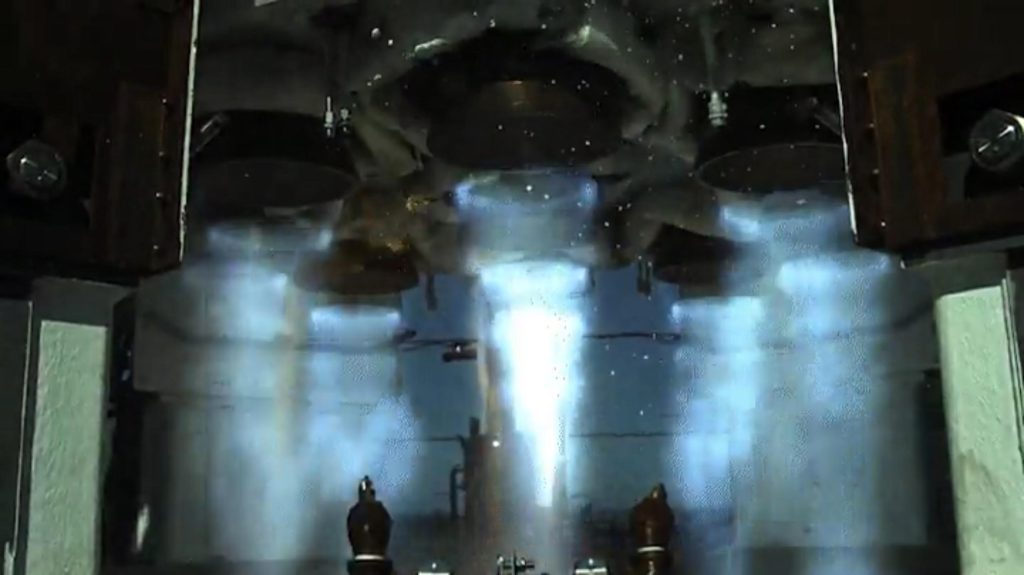
According to engineers onsite during a private Teslarati tour of Relativity’s Florida launch facilities, Terran 1 S1’s next goal is to fully ignite its Aeon engines. After one or more successful static fires, the booster will be integrated with the upper stage and nosecone for a final full-duration static fire test that will also double as a full wet dress rehearsal (WDR). Testing the fully-integrated Terran 1 rocket will only be possible once LC-16’s full strongback and launch mount (also known as a transporter/erector) is completed, but that final piece of the puzzle should be ready any day now.
De Terra Ad Astra
The coming weeks will likely be some of the company’s riskiest and most difficult yet. If the rocket and LC-16 continue to operate as smoothly as they have been, however, there’s a nonzero chance that Terran 1 could beat the likes of SpaceX (Starship), Blue Origin (New Glenn), and the United Launch Alliance (Vulcan Centaur) to the punch to become the first methane and oxygen-fueled rocket in history to attempt an orbital launch.*
*While SpaceX’s Starship is technically the first large-scale suborbital methalox rocket to attempt (and complete) a launch, there has never been an orbital methalox launch attempt.
Capable of carrying up to 1.25 tons (~2750 lb) to low Earth orbit for as little as $12 million, Terran 1 also has a shot at becoming the first new privately-developed 1-ton-class rocket of any kind to successfully reach orbit. On that front, though, Relativity is in a neck-and-neck race with Firefly Aerospace and ABL Space, both of which intend to launch similarly-sized rockets at some point in the next few months. It’s never been less clear who will cross the finish line first but one would be hard-pressed to count Relativity out.
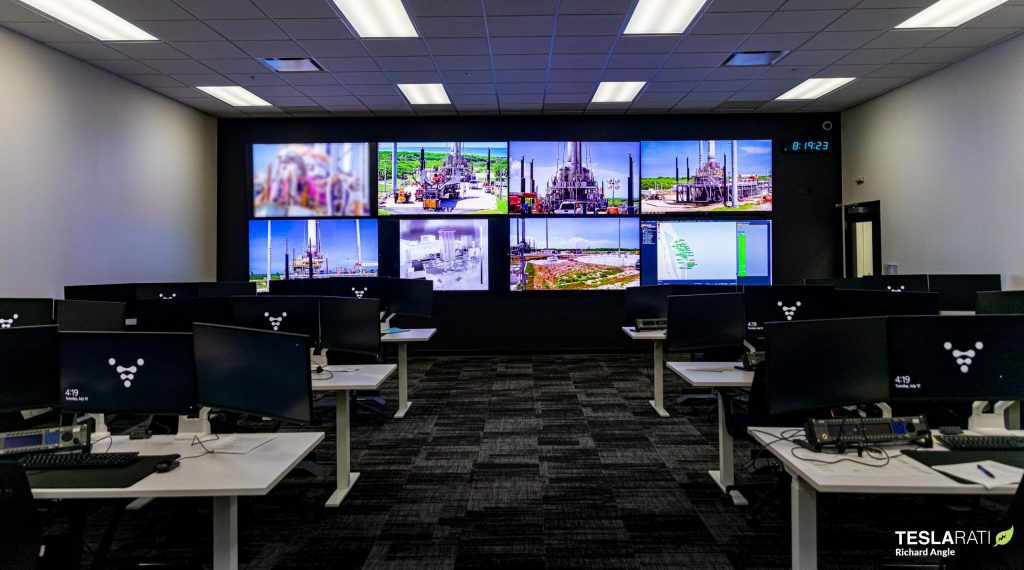

News
Tesla Diner becomes latest target of gloom and doom narrative

The Tesla Diner has been subject to many points of criticism since its launch in mid-2025, and skeptics and disbelievers claim the company’s latest novel concept is on its way down, but there’s a lot of evidence to state that is not the case.
The piece cites anecdotal evidence like empty parking lots, more staff than customers during a December visit, removed novelty items, like Optimus robot popcorn service and certain menu items, the departure of celebrity chef Eric Greenspan in November 2025, slow service, high prices, and a shift in recent Google/Yelp reviews toward disappointment.
The piece frames this as part of broader Tesla struggles, including sales figures and Elon Musk’s polarizing image, calling it a failed branding exercise rather than a sustainable restaurant.
This narrative is overstated and sensationalized, and is a good representation of coverage on Tesla by today’s media.
Novelty Fade is Normal, Not Failure
Any hyped launch, especially a unique Tesla-branded destination blending dining, Supercharging, and a drive-in theater, naturally sees initial crowds taper off after the “Instagram effect” wears down.
Tesla makes major change at Supercharger Diner amid epic demand
This is common for experiential spots in Los Angeles, especially pop-up attractions or celebrity-backed venues. The article admits early success with massive lines and social media buzz, but treats the return to normal operations as “dying down.”
In reality, this stabilization is a healthy sign of transitioning from hype-driven traffic to steady patronage.
Actual Performance Metrics Contradict “Ghost Town” Claims
- In Q4 2025, the Diner generated over $1 million in revenue, exceeding the average McDonald’s location
- It sold over 30,000 burgers and 83,000 fries in that quarter alone. These figures indicate a strong ongoing business, especially for a single-location prototype focused on enhancing Supercharger experiences rather than competing as a mass-market chain
It’s not a ghost town lol. The @Tesla Diner still had over 30,000 burger orders and 83,000 fries orders in Q4. The diner generated over $1M in revenue in Q4, a $4M annual run rate, which is more than the average McDonald’s…. pic.twitter.com/XvAGLUqxej
— Sawyer Merritt (@SawyerMerritt) January 4, 2026
Conflicting On-the-Ground Reports
While the article, and other similar pieces, describe a half-full parking lot and sparse customers during specific off-peak visits, other recent accounts push back:
- A January 2026 X post noted 50 of 80 Supercharger stalls were busy at 11 a.m., calling it “the busiest diner in Hollywood by close to an order of magnitude
TESLA DINER 🍔
Frantic!!!
Crazy busy. pic.twitter.com/wMbmr8SFFn
— Rich & Sharon (@HullTeslaModel3) January 4, 2026
- Reddit discussions around the same time describe it as not empty when locals drive by regularly, with some calling the empty narrative “disingenuous anti-Tesla slop.”
When we visited it last week it was packed. We had to wait to enter, get a table and go to the restroom. We were lucky to find a spot to charge.
— Rani G (@ranig) January 4, 2026
Bottom Line
The Tesla Diner, admittedly, is not the nonstop circus it was at launch–that was never sustainable or intended. But, it’s far from “dying” or an “empty pit stop.”
It functions as a successful prototype: boosting Supercharger usage, generating solid revenue, and serving as a branded amenity in the high-traffic EV market of Los Angeles.
News
Tesla stands to win big from potential adjustment to autonomous vehicle limitations
Enabling scale, innovation, and profitability in a sector that is growing quickly would benefit Tesla significantly, especially as it has established itself as a leader.

Tesla stands to be a big winner from a potential easing of limitations on autonomous vehicle development, as the United States government could back off from the restrictions placed on companies developing self-driving car programs.
The U.S. House Energy and Commerce subcommittee will hold a hearing later this month that will aim to accelerate the deployment of autonomous vehicles. There are several key proposals that could impact the development of self-driving cars and potentially accelerate the deployment of this technology across the country.
These key proposals include raising the NHTSA’s exemption cap from 2,500 to 90,000 vehicles per year per automaker, preempting state-level regulations on autonomous vehicle systems, and mandating NHTSA guidelines for calibrating advanced driver assistance systems (ADAS).
Congress, to this point, has been divided on AV rules, with past bills like the 2017 House-passed measure stalling in the Senate. Recent pushes come from automakers urging the Trump administration to act faster amid competition from Chinese companies.
Companies like Tesla, who launched a Robotaxi service in Austin and the Bay Area last year, and Alphabet’s Waymo are highlighted as potential beneficiaries from lighter sanctions on AV development.
The NHTSA recently pledged to adopt a quicker exemption review for autonomous vehicle companies, and supporters of self-driving tech argue this will boost U.S. innovation, while critics are concerned about safety and job risks.
How Tesla Could Benefit from the Proposed Legislation
Tesla, under CEO Elon Musk’s leadership, has positioned itself as a pioneer in autonomous driving technology with its Full Self-Driving software and ambitious Robotaxi plans, including the Cybercab, which was unveiled in late 2024.
The draft legislation under consideration by the U.S. House subcommittee could provide Tesla with significant advantages, potentially transforming its operational and financial landscape.
NHTSA Exemption Cap Increase
First, the proposed increase in the NHTSA exemption cap from 2,500 to 90,000 vehicles annually would allow Tesla to scale up development dramatically.
Currently, regulatory hurdles limit how many fully autonomous vehicles can hit the roads without exhaustive approvals. For Tesla, this means accelerating the rollout of its robotaxi fleet, which Musk envisions as a network of millions of vehicles generating recurring revenue through ride-hailing. With Tesla’s vast existing fleet of over 6 million vehicles equipped with FSD hardware, a higher cap could enable rapid conversion and deployment, turning parked cars into profit centers overnight.
Preempting State Regulations
A united Federal framework would be created if it could preempt State regulations, eliminating the patchwork of rules that currently complicate interstate operations. Tesla has faced scrutiny and restrictions in states like California, especially as it has faced harsh criticism through imposed testing limits.
A federal override of State-level rules would reduce legal battles, compliance costs, and delays, allowing Tesla to expand services nationwide more seamlessly.
This is crucial for Tesla’s growth strategy, as it operates in multiple markets and aims for a coast-to-coast Robotaxi network, competing directly with Waymo’s city-specific expansions.
Bringing Safety Standards to the Present Day
Innovation in the passenger transportation sector has continued to outpace both State and Federal-level legislation, which has caused a lag in the development of many things, most notably, self-driving technology.
Updating these outdated safety standards, especially waiving requirements for steering wheels or mirrors, directly benefits Tesla’s innovative designs. Tesla wanted to ship Cybertruck without side mirrors, but Federal regulations required the company to equip the pickup with them.
Cybercab is also planned to be released without a steering wheel or pedals, and is tailored for full autonomy, but current rules would mandate human-ready features.
Streamlined NHTSA reviews would further expedite approvals, addressing Tesla’s complaints about bureaucratic slowdowns. In a letter written in June to the Trump Administration, automakers, including Tesla, urged faster action, and this legislation could deliver it.
In Summary
This legislation represents a potential regulatory tailwind for Tesla, but it still relies on the government to put forth action to make things easier from a regulatory perspective. Enabling scale, innovation, and profitability in a sector that is growing quickly would benefit Tesla significantly, especially as it has established itself as a leader.
News
Nvidia CEO Jensen Huang explains difference between Tesla FSD and Alpamayo
“Tesla’s FSD stack is completely world-class,” the Nvidia CEO said.

NVIDIA CEO Jensen Huang has offered high praise for Tesla’s Full Self-Driving (FSD) system during a Q&A at CES 2026, calling it “world-class” and “state-of-the-art” in design, training, and performance.
More importantly, he also shared some insights about the key differences between FSD and Nvidia’s recently announced Alpamayo system.
Jensen Huang’s praise for Tesla FSD
Nvidia made headlines at CES following its announcement of Alpamayo, which uses artificial intelligence to accelerate the development of autonomous driving solutions. Due to its focus on AI, many started speculating that Alpamayo would be a direct rival to FSD. This was somewhat addressed by Elon Musk, who predicted that “they will find that it’s easy to get to 99% and then super hard to solve the long tail of the distribution.”
During his Q&A, Nvidia CEO Jensen Huang was asked about the difference between FSD and Alpamayo. His response was extensive:
“Tesla’s FSD stack is completely world-class. They’ve been working on it for quite some time. It’s world-class not only in the number of miles it’s accumulated, but in the way it’s designed, the way they do training, data collection, curation, synthetic data generation, and all of their simulation technologies.
“Of course, the latest generation is end-to-end Full Self-Driving—meaning it’s one large model trained end to end. And so… Elon’s AD system is, in every way, 100% state-of-the-art. I’m really quite impressed by the technology. I have it, and I drive it in our house, and it works incredibly well,” the Nvidia CEO said.
Nvidia’s platform approach vs Tesla’s integration
Huang also stated that Nvidia’s Alpamayo system was built around a fundamentally different philosophy from Tesla’s. Rather than developing self-driving cars itself, Nvidia supplies the full autonomous technology stack for other companies to use.
“Nvidia doesn’t build self-driving cars. We build the full stack so others can,” Huang said, explaining that Nvidia provides separate systems for training, simulation, and in-vehicle computing, all supported by shared software.
He added that customers can adopt as much or as little of the platform as they need, noting that Nvidia works across the industry, including with Tesla on training systems and companies like Waymo, XPeng, and Nuro on vehicle computing.
“So our system is really quite pervasive because we’re a technology platform provider. That’s the primary difference. There’s no question in our mind that, of the billion cars on the road today, in another 10 years’ time, hundreds of millions of them will have great autonomous capability. This is likely one of the largest, fastest-growing technology industries over the next decade.”
He also emphasized Nvidia’s open approach, saying the company open-sources its models and helps partners train their own systems. “We’re not a self-driving car company. We’re enabling the autonomous industry,” Huang said.








